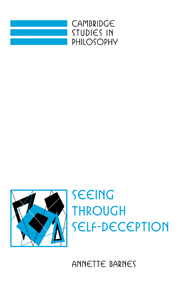Book contents
- Frontmatter
- Contents
- Acknowledgments
- Introduction
- 1 Other-deception
- 2 Two models of self-deception
- 3 The need for an alternative model of self-deception
- 4 Functioning to reduce an anxiety; satisfying a desire
- 5 Self-deceptive belief formation: non-intentional biasing
- 6 False consciousness
- 7 Intentional and non-intentional deception of oneself
- 8 Irrationality
- 9 What, if anything, is objectionable about self- and other-deception?
- References
- Index
4 - Functioning to reduce an anxiety; satisfying a desire
Published online by Cambridge University Press: 09 November 2009
- Frontmatter
- Contents
- Acknowledgments
- Introduction
- 1 Other-deception
- 2 Two models of self-deception
- 3 The need for an alternative model of self-deception
- 4 Functioning to reduce an anxiety; satisfying a desire
- 5 Self-deceptive belief formation: non-intentional biasing
- 6 False consciousness
- 7 Intentional and non-intentional deception of oneself
- 8 Irrationality
- 9 What, if anything, is objectionable about self- and other-deception?
- References
- Index
Summary
In the preceding chapter I claimed that a self-deceptive belief that p functions to reduce the self-deceiver's anxiety that not-q and that the anxiety that not-q could be reduced without the desire that q being satisfied. In this chapter I consider further cases of self-deception, distinguishing those in which the relevant anxiety is reduced and the relevant desire is not satisfied from those in which the relevant anxiety is reduced and the relevant desire is satisfied. Two notions are crucial here: that of a belief functioning to reduce anxiety and that of a desire being satisfied. Let me explain how these notions are to be understood.
A belief's causing an anxiety to be reduced is not sufficient for the belief's functioning to reduce that anxiety. As I use the expression “functions to reduce anxiety,” a belief that p functions to reduce anxiety that not-q when (1) the belief that p is caused by the anxious desire that q and (2) the purpose of the occurrence of the belief that p is to reduce anxiety that not-q. While I thus define “functions to reduce anxiety,” I am not claiming thereby to analyze “function” in whatever is its main sense.
According to requirement 2, the having of the belief that p is purposive; its purpose is to reduce anxiety that not-q. According to requirement 1, the anxious desire plays a causal role in the person's coming to have that belief. In the next chapter I discuss that causal role in detail.
- Type
- Chapter
- Information
- Seeing through Self-Deception , pp. 59 - 76Publisher: Cambridge University PressPrint publication year: 1998



